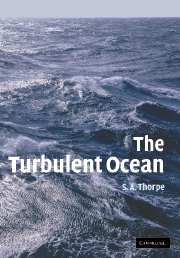Book contents
- Frontmatter
- Contents
- Preface
- Structure and résumé
- Acknowledgements
- 1 Heat, buoyancy, instability and turbulence
- 2 Neutral stability: internal waves
- 3 Instability and transition to turbulence in stratified shear flows
- 4 Convective instabilities
- 5 Instability and breaking of internal waves in mid-water
- 6 The measurement of turbulence and mixing
- 7 Fine-structure, transient-structures, and turbulence in the pycnocline
- 8 The benthic boundary layer
- 9 The upper ocean boundary layer
- 10 Shallow seas
- 11 Boundary layers on beaches and submarine slopes
- 12 Topographically related turbulence
- 13 Large-scale waves, eddies and dispersion
- 14 Epilogue
- Appendices
- References
- Index of laboratory experiments
- Subject index
- Plate section
13 - Large-scale waves, eddies and dispersion
Published online by Cambridge University Press: 05 June 2012
- Frontmatter
- Contents
- Preface
- Structure and résumé
- Acknowledgements
- 1 Heat, buoyancy, instability and turbulence
- 2 Neutral stability: internal waves
- 3 Instability and transition to turbulence in stratified shear flows
- 4 Convective instabilities
- 5 Instability and breaking of internal waves in mid-water
- 6 The measurement of turbulence and mixing
- 7 Fine-structure, transient-structures, and turbulence in the pycnocline
- 8 The benthic boundary layer
- 9 The upper ocean boundary layer
- 10 Shallow seas
- 11 Boundary layers on beaches and submarine slopes
- 12 Topographically related turbulence
- 13 Large-scale waves, eddies and dispersion
- 14 Epilogue
- Appendices
- References
- Index of laboratory experiments
- Subject index
- Plate section
Summary
Introduction
Except for the partly ice-covered polar oceans – the Southern Ocean that circumscribes the Antarctic continent, and the Arctic Ocean – the major oceans of this planet, the Atlantic, Pacific and Indian Oceans, are confined in the meridional direction by the presence of the continental landmasses to basins of scales of between 0.8 and 2.3 Earth radii. These boundaries, the wind fields and the presence of the Equator, result in a mean circulation pattern of the upper levels of the subtropical oceans with the form of anticyclonic ‘gyres’ in which the currents are intensified on their western boundaries, forming major currents, for example the Gulf Stream in the North Atlantic and the Kuroshio in the North Pacific.
Until the early 1960s the circulating flows, particularly in the major gyres, were believed to be subject to relatively little variability. Although some changes in surface currents in response to variations in wind forcing were known to occur, the deeper motions were supposed to be much slower and almost steady. This view was proved wrong by the measurements of Swallow and Crease in the deep Atlantic. Using the newly invented, neutrally buoyant floats, the ‘Swallow floats’ described in Section 1.3, it was discovered that the currents at a depth of 4000m are sometimes as strong as those near the surface, of order 0.1 m s−1, and that they vary at a particular location over time scales of a few weeks (Crease, 1962; Swallow, 1971).
- Type
- Chapter
- Information
- The Turbulent Ocean , pp. 340 - 367Publisher: Cambridge University PressPrint publication year: 2005



